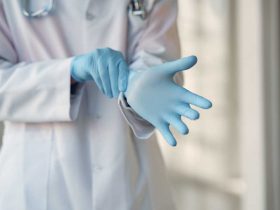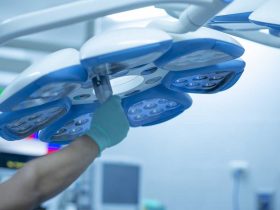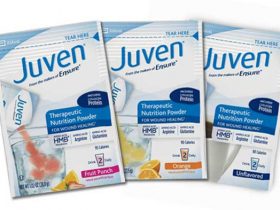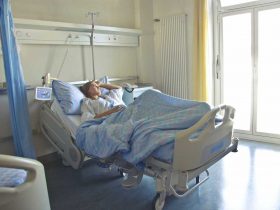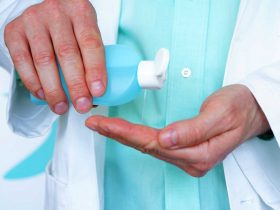Wound Glossary
It is important to be able to speak the same language as your wound care providers. This glossary will help you understand the basic terminology.
Air-Flotation Bed: Generic descriptor for low-air-loss beds and air-fluidized beds.
Air-Fluidized Bed: Class of support surfaces that uses a high rate of air flow to fluidize fine particulate material (such as sand) to produce a support medium that has characteristics similar to a liquid.
Autolysis: Process of autodigestion (self-digestion) of cells, occurring in injured cells or dying tissue.
Autolytic Debridement: The use of synthetic dressings to cover a wound and allow eschar to self-digest by the action of enzymes present in wound fluids.
Bottoming Out: Expression used to describe inadequate support from a mattress overlay or seat cushion as determined by a “hand check.” To perform a hand check, the caregiver places an outstretched hand (palm up) under the overlay or cushion below the pressure injury or the part of the body at risk for a pressure injury. If the caregiver feels less than an inch of support material, the individual has bottomed out and the support surface is therefore inadequate.
Chemical Debridement: The topical application of proteolytic substances (enzymes) to breakdown devitalized tissue.
Clean Dressing: Dressing that is not sterile but is free of environmental contaminants.
Colonized: The presence of bacteria on the surface or in the tissue of a wound without indications of infection such as purulent exudate, foul odor, or surrounding inflammation. All Stages 2, 3, and 4 pressure injuries are colonized.
Contaminated: Containing bacteria, other microorganisms, or foreign material. The term usually refers to bacterial contamination and in this context is synonymous with colonized. Wounds with bacterial counts of 105 organisms per gram of tissue or less are generally considered contaminated; those with higher counts are generally considered infected.
Cytotoxic Cleansers: Agents that can be used to cleanse wounds (to remove undesirable materials) but that have a specific destructive action on certain cells.
Dakin’s® Solution: Buffered sodium hypochlorite; a bactericidal wound irrigant.
Debridement: Removal of devitalized tissue and foreign matter from a wound through autolytic, biologic, enzymatic, chemical, mechanical, and sharp debridement methods.
Deterioration: Negative course. Failure of the pressure injury to heal, as shown by wound enlargement that is not brought about by debridement.
Devitalized Tissue: Tissue that has died and has therefore lost its usual physical properties and biological activity.
Dressing: The material applied to a wound for the protection of the wound and absorbance of drainage.
Dynamic Device: Pressure-redistributing device designed to change its support characteristics in a cyclical fashion. Examples include alternating-air mattresses and mechanical seats that change shape and redistribute pressure.
Electrical Stimulation: The use of an electrical current to transfer energy to a wound. The type of electricity that is transferred is controlled by the electrical source.
Epithelialization: The stage of tissue healing in which the epithelial cells migrate (move) across the surface of a wound. During this stage of healing, the epithelium appears the color of “ground glass” to pink.
Eschar: Thick, leathery, necrotic, devitalized tissue.
Exudate: Any fluid that is extruded from a tissue or its capillaries, more specifically because of injury or inflammation. It is characteristically high in protein and white blood cells.
Fluid Irrigation: Cleansing by means of a stream of fluid.
Foam Mattress Overlay: Thick foam slab with a textured surface designed to be placed on top of the standard hospital mattress to reduce pressure by enveloping the body. Its effectiveness is influenced by its thickness, density, and stiffness.
Friction: Mechanical force exerted when skin is dragged across a coarse surface such as bed linens.
Granulation Tissue: The pink/red, moist tissue that contains new blood vessels, collagen, fibroblasts, and inflammatory cells, which fills an open, previously deep wound when it starts to heal.
Hydrotherapy: Use of whirlpool or submersion in water for wound cleansing.
Hyperbaric Oxygen: Oxygen at greater than atmospheric pressure applied to patient inside a pressurized chamber.
Infection: The presence of bacteria or other microorganisms in sufficient quantity to damage tissue or impair healing. Clinical experience has indicated that wounds can be classified as infected when the wound tissue contains 105 or greater microorganisms per gram of tissue. Clinical signs of infection may not be present, especially in the immunocompromised patient or the patient with a chronic wound.
Interface Pressure: Force per unit area that acts perpendicularly between the body and the support surface. This parameter is affected by the stiffness of the support surface, the composition of the body tissue, and the geometry of the body being supported.
Irrigation: Cleansing by a stream of fluid.
Low-Air-Loss Bed: A series of interconnected woven fabric air pillows that allow some air to escape through the support surface. The pillows can be variably inflated to adjust the level of pressure redistribution.
Mattress Replacement System: Mattress with pressure-redistribution features that can be placed on an existing bed frame.
Mechanical Debridement: Removal of foreign material and devitalized or contaminated tissue from a wound by physical force. Examples are wet-to-dry dressings, wound irrigation, and whirlpool.
Mechanical Loading: The contribution of mechanical forces—ie, pressure, friction, and shear—to the development of pressure injuries.
Necrosis: Death or disintegration of a cell or tissues caused by disease or injury.
Necrotic Tissue: Tissue that has died and therefore has lost its usual physical properties and biological activity. Also called “devitalized tissue.”
No-Touch Technique: Method of changing surface dressings without touching the wound or the surface of any dressing that may be in contact with the wound.
Overlay: General term used to describe support surfaces placed on top of a standard hospital mattress.
Pressure (Interface): Force per unit area that acts perpendicularly between the body and the support surface. This parameter is affected by the stiffness of the support surface, the composition of the body tissue, and the geometry of the body being supported.
Pressure Redistribution: The ability of a support surface to distribute load over the contact areas of the human body.
Pressure Injury: In the past, pressure injuries were sometimes called pressure ulcers, bedsores, or decubitus ulcers. A pressure injury is localized damage to the skin and underlying soft tissue usually over a bony prominence or related to a medical or other device. The injury can present as intact skin or an open ulcer and sometimes is painful. The injury occurs as a result of intense and/or prolonged pressure or pressure in combination with shear. Microclimate, nutrition, perfusion, comorbidities, and condition of the soft tissue also may affect the tolerance of soft tissue for pressure and shear.
Repositioning: Any change in body position that relieves pressure from tissue overlying bony prominences. The term “repositioning” implies a sustained relief of pressure, not just a temporary shift.
Secondary Intention Healing: Closure and healing of a wound by the formation of granulation tissue and epithelialization.
Sharp Debridement: Removal of foreign material or devitalized tissue by a sharp instrument such as a scalpel.
Shear: Mechanical force that acts on a unit area of skin in a direction parallel to the body’s surface. Shear is affected by the amount of pressure exerted, the coefficient of friction between the materials contacting each other, and the extent to which the body makes contact with the support surface.
Sinus Tract: A cavity or channel underlying a wound that involves an area larger than the visible surface of the wound.
Slough: Necrotic (dead) tissue in the process of separating from viable portions of the body.
Support Surfaces: Special beds, mattresses, mattress overlays, or seat cushions that reduce or relieve pressure while sitting or lying.
Tissue Load: The distribution of pressure, friction, and shear on tissue.
Topical Antibiotic: A drug known to inhibit or kill microorganisms that can be applied locally to a tissue surface.
Topical Antiseptic: Product with antimicrobial activity designed for use on skin or other superficial tissues; may damage some cells.
Tunneling: A passageway under the surface of the skin that is generally open at the skin level; however, most of the tunneling is not visible.
Undermining: A closed passageway under the surface of the skin that is open only at the skin surface. Generally, it appears as an area of skin ulceration at the margins of the wound with skin overlying the area. Undermining often develops from shearing forces.









